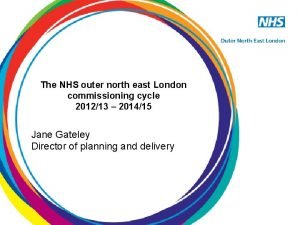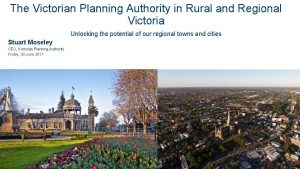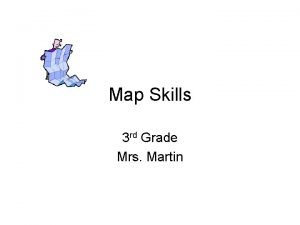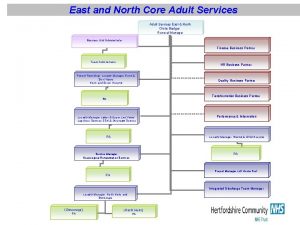Skills Context North East LEP 22 th March

































- Slides: 33

Skills Context – North East LEP 22 th March 2016 Michelle Duggan Fiona Thom

Introduction • Current context – overview of evidence – Population – Labour market – Skills • Future projections – Population – Labour market – Skills • North East LEP strategy and policy

Current context – evidence base

Current North East LEP economy

Population of North East LEP

Employment rates have returned to pre recession levels and the gap is closing with the national average… …employment levels are still consistently below the national average, and the region has the highest unemployment and economic inactivity levels in Derived from NOMIS the. Source: country.

7. 0 6. 0 5. 0 4. 0 3. 0 2. 0 1. 0 0. 0 5. 4 5. 3 Northumberland 5. 9 Great Britain North Tyneside 7. 4 Gateshead 7. 5 County Durham 7. 3 South Tyneside 9. 0 Sunderland 9. 0 Newcastle upon Tyne 8. 0 NE LEP 10. 0 Unemployment by LA 8. 6 7. 1

Economic inactivity levels are highest in the country, but falling. GB Family_home, 26 0 10 20 student, 26 30 LT sick, 28 Retired, 15 LT sick, 22 40 50 60 % of people who are inactive 70 Retired, 14 80 90 Other, 7 student, 24 Other, 10 Family_home, 23 ST sick, 2 NE LEP ST sick, 2 Reason of inactivity, working age population (%) 100 Ill health represents the largest proportion of those who are inactive (28%) much higher than national average. This has been slowly falling in recent months and inactivity due to being a student and looking after family/home has increased. Source: Derived from NOMIS

Reason of inactivity by LA (%) sunderland 22. 5 S. Tyneside 17. 9 Northumberl and 17. 3 N. tyneside 24. 2 31. 1 21. 6 29. 5 27. 1 23. 8 Newcastle Upon tyne Gateshead 24. 9 Durham 23. 4 21. 5 28. 6 23. 7 0% 20% 60% % of NE LEP inactivity 86, 200 30% 25% 62, 700 20% 43, 000 15% 41, 000 32, 900 32, 100 10% 21, 400 5% sid e ne Ty S. N. ty ne sid e ad he es nd Ga t rla nd um be rth de r la . . . on Up su n No Ne w ca st le Du rh am 0% % discouraged 9. 8 15. 9 31. 7 40% % long-term sick 17. 6 26. 4 18. 2 % temporary sick 24. 6 21. 6 35. 1 % looking after family/home 20. 1 21. 7 24. 1 % student 12. 2 % retired 13. 7 80% % other 100% 120%

NEET levels are the highest in the country and rising… NEET: aged 16 -18 years 9. 0% North East 8. 0% North East LEP England 30. 0% % of age group 7. 0% 6. 0% NEET: aged 19 -24 years, by region 25. 0% 4. 0% 20. 0% 3. 0% 2. 0% 15. 0% 1. 0% 0. 0% 2012 2013 2014 10. 0% England North East North West Yorks & Humber 5. 0% 0. 0% 2008 2009 Source: DWP 2010 2011 2012 2013 2014

Unemployment of those aged 50+ is another key challenge for the area Age Group 16 -19 20 -24 25 -49 50 -64 65+ Average England 35. 5% 66. 9% 82. 7% 69. 8% 10. 5% Highest 52. 8% rank LEP 79. 1% 88. 4% 79% 22% NE LEP 62. 4% (30 th) 79. 6% (34 th) 63. 7% (38 th) 6. 8% (37 th) 36. 3% (23 rd) Lowest 22. 7% Rank LEP 55. 5% 74. 3% 62. 1% 6. 1%

Key sectors in the North East Employment by industry (%): NE LEP 14/15 Agriculture and fishing 5. 7 Energy and water 1. 02. 3 10. 8 Manufacturing 7. 1 33. 7 19. 0 12. 3 Source: ONS Oct 15 7. 0 Over 80% of our workforce jobs are in services and this is growing. Construction Distribution, hotels and restaurants Transport and communications Banking, finance and insurance Public admin. education and health Other services 11% of workforce jobs are in self employment.

The skills profile of current population is lower than the national average… 29% working age population have higher level skills vs. national average of 36% % 45 Age 16 -24 40 Age 50 -64 Age 25 -49 NELEP 35 30 25 20 15 10 • The skill level gap in the older working age group is the most striking, with a larger proportion of over 50’s with L 1/2 or no qualifications • Whilst the younger working age group who are the flow into the labour market have higher level skills No quals Other quals NVQ 1 NVQ 2 Trade Apprenticeships NVQ 3 NVQ 4+ No quals Other quals % with NVQ 1 NVQ 2 Trade Apprenticeships Source: ONS (Nomis) Jan-Dec 2014 NVQ 3 0 NVQ 4+ 5

Looking at occupations of those in employment in the region, we see a similar pattern… 25. 0 20. 0 NE LEP England 15. 0 10. 0 5. 0 0. 0 1: managers, 2: professional 3: associate prof 4: administrative 5: skilled trades 6: caring, leisure 7: sales and 8: process, plant 9: elementary directors and occupations & tech and secretarial occupations and other customer service and machine occupations senior officials occupations service occupations operatives occupations

Yet, there is now more people qualified to L 4 than jobs available at this level… Change in L 4 qualifications and L 4 jobs : 2004 -2014 400, 000 350, 000 300, 000 250, 000 200, 000 SOC level 4+ jobs 150, 000 Population qualified to NVQ 4+ 100, 000 50, 000 0 2004 2005 2006 2007 2008 2009 2010 2011 2012 2013 2014


Education profile – flow into labour market % of pupils achieving 5+ GSCE passes A*-C, including English and maths 70. 0 65. 0 62. 0 % of pupils 60. 0 57. 3 55. 0 55. 4 50. 0 50. 3 Total England (state-funded sector) North East Best in region Worst in region 45. 0 40. 0 Source: Df. E 2009/10 2010/11 2011/12 2012/13 2013/14 2014/15

GCSE achievements by facilitating subject, 14/15 Best LA England state funded North East Worst LA 90. 0 80. 0 79. 9 74. 2 75. 2 72. 6 70. 0 61. 9 68. 1 63. 0 56. 9 60. 0 66. 6 59. 9 50. 0 40. 0 30. 0 20. 0 10. 0 English Mathematics Sciences History or Geography Languages

A level achievement is below the national average… 94. 0 92. 0 % of students achieving 2+ substantial level 3 qualifications England state funded 91. 7 91. 2 North East 90. 8 89. 7 90. 0 North East LEP 89. 3 87. 8 %88. 0 86. 0 84. 0 82. 0 2012/13 2013/14 2014/15 Those achieving high grades is even lower…a key challenge for the region.

30. 0 Entries for maths and science A levels: 14/15 County Durham 25. 0 Gateshead 20. 0 Newcastle upon Tyne 15. 0 North Tyneside 10. 0 Northumberland 5. 0 South Tyneside Computing Physics Chemistry Biological Sciences Further Mathematics 0. 0 Sunderland England (state schools and colleges)

Apprenticeship starts are increasing… 30, 000 Number of apprenticeship starts by age - NE LEP learners 25+ 19 -24 16 -18 25, 000 20, 000 15, 000 The top three subjects for apprenticeship starts: • health and social care (40%) • administration (40%) • manufacturing technologies (11%). 10, 000 5, 000 Level of apprenticeship starts: 14/15 0 2011/12, Quarter 2012/13, Quarter 2013/14, Quarter 2014/15, Quarter 4 4 18% of workplaces in the North East employ apprentices, the highest in the country. (National average of 14%) The NE target is 30% by 2020. 33% Advanced Level Apprenticeship Higher Apprenticeship 62% 5% Intermediate Level Apprenticeship

Demand for skills – vacancy data Top 10 occupations… Top 10 specialist skills… Vacancies in the NE LEP area: Nov 14 -15 Family/School/General Social Worker 1. 6% Janitor / Cleaner 1. 6% Delivery Driver 1. 6% Retail Supervisor 1. 7% Office / Administrative Assistant Customer Service Representative Secondary School Teacher (Middle School) SQL Source: Active Informatics 2. 2% Rehabilitatio n 2. 2% 2. 7% Mathematics 2. 5% 2. 7% 2. 9% Business Development 4. 2% 500 Microsoft C# Business Management 3. 4% 0 2. 2% 2. 7% 2. 9% Registered General Nurse (RGN) Software Developer / Engineer . NET Programming Repair 1. 8% Sales Representative 2. 2% 1, 000 1, 500 3. 0% Sales 4. 3% Java. Script 4. 3% 0 1, 000 2, 000 3, 000 4, 000 5, 000

Future projections

Population rising, driven by an increase in older age groups… Population age breakdown: 2014 and 2024 2014 NE LEP 2024 2014 2024 England

There is expected to be a change in occupational requirement between in the region driven by new growth and replacement demand…. All occupations thousands 60 50 40 30 20 10 0 -10 2012 - 2013 - 2014 - 2015 - 2016 - 2017 - 2018 - 2019 - 2020 - 2021 - 2022 Expansion demand Replacement demand Net requirement

…across all occupational levels % change in occupations 2012 – 2022 9. Elementary occupations 8. Process, plant and machine operatives 7. Sales and customer service 6. Caring, leisure and other service Total Requirement Replacement Demand 5. Skilled trades occupations Net Change 4. Administrative and secretarial 3. Associate professional and technical 2. Professional occupations 1. Managers, directors and senior officials -20. 0 Source: Working Futures UKCES -10. 0 20. 0 30. 0 40. 0 50. 0 60. 0 70. 0

Demand for higher skills

There is expected to be a continued decline in manufacturing sector and primary sectors with a growth in business and services. Non-market services 0. 2 Business and other services 1. 2 Trade, accomod. and transport 0. 2 Construction 1. 2 Manufacturing -0. 8 Primary sector -0. 3 and utilities -1. 0 -0. 5 0. 0 0. 5 1. 0 1. 5

Strategy / Policy

Focus on key sectors in the future • Future employment sectors – smart specialisation – Passenger Vehicle Manufacturing - major foreign inward investments of strategic national importance which can stimulate supply chain innovation and business growth and inward investment – Subsea and Offshore Technology – opportunities for indigenous business growth building on national and local innovation assets/capabilities, and attraction of new enterprise – Life Sciences and Healthcare - a major manufacturing, employment and export footprint, diverse industrial base and local R&D capabilities. A potentially strong translational environment in the local public sector – Creative, Digital, Software and Technology Based Services - a mixed AEA which shares technology and skills bases and provides a key enabling technology capability to other business growth industries. Strong science assets • Tactical sector approaches – health and social care, rail / transport, inward investment priorities

Challenges and responses • Devolution – Area based reviews – Whole system view • Living wage – Quality and structure • Aging population and replacement demand – Forecasting and workforce planning for key industries • Skill levels – Target investment, stimulate employer investment • Drive up quality apprenticeships – Support transition to the levy, campaigns and influencers • Coherence in IAG – Create a shared framework for delivery

What next? • Refine the communication and information output • Create an interactive approach to intelligence • Develop a dashboard for performance • Develop evidence base as part of the SEP refresh and economic evidence review • Investigate matching tools and opportunities for matching supply and demand. • Collaborate and work in partnership

 South east midlands lep
South east midlands lep North east and north cumbria ics map
North east and north cumbria ics map Poland national anthem lyrics
Poland national anthem lyrics Ustálené pomenovania
Ustálené pomenovania Clarence valley lep
Clarence valley lep Lep
Lep Lycée professionnel jules antonini
Lycée professionnel jules antonini Lep sidney
Lep sidney Lep workshop
Lep workshop Ciwa b
Ciwa b Lep l
Lep l Tomi lep
Tomi lep West north west wind direction
West north west wind direction Laissez faire theory
Laissez faire theory East is east and west is west
East is east and west is west Outer north east london
Outer north east london Great plains of canada
Great plains of canada North east west south map
North east west south map The meeting of longitude and latitude lines
The meeting of longitude and latitude lines Fifty nifty united states
Fifty nifty united states 50 nifty united states
50 nifty united states North east rural livelihood project
North east rural livelihood project North south east west leadership styles
North south east west leadership styles Wonthaggi north east psp
Wonthaggi north east psp Neisd calander
Neisd calander North east nhs
North east nhs North east south west
North east south west North east hampshire and farnham ccg
North east hampshire and farnham ccg Pest control bath and north east somerset
Pest control bath and north east somerset Education in north east india
Education in north east india North, south east west leadership styles
North, south east west leadership styles Tamassia martins
Tamassia martins Http //go.hrw.com/atlas/norm htm/world.htm
Http //go.hrw.com/atlas/norm htm/world.htm Nottingham north and east ccg
Nottingham north and east ccg

























































